#category: analysis
Explore tagged Tumblr posts
Text
Did any of the Strawhat's even go to school?
Chapter 1134 has sparked discussions on the state of the Strawhat's education, so I figured I would do a little analysis on my thoughts on it based on canon.
Luffy- Feral jungle child. Makino probably taught him to read and write, and attempted to teach him manners. Jury is out on whether or not Garp actually taught him anything. Doesn't seem to know much history. Does know beetles, and probably a lot of survival skills, including hunting.
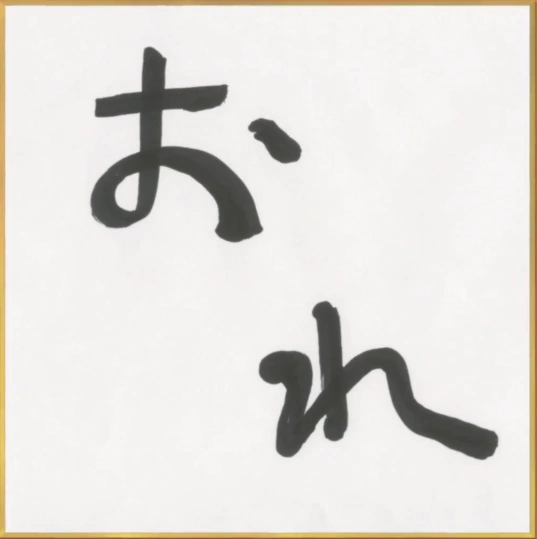

Zoro- Ok this is the real reason why I made this post.
A dōjō (道場, Japanese pronunciation: [doꜜː(d)ʑoː]) is a hall or place for immersive learning, experiential learning, or meditation. This is traditionally in the field of martial arts. The term literally means "place of the Way" in Japanese. -Wikipedia
Isshin Dojo (一心道場, Isshin Dōjō?) is a kenjutsu school, a school of Japanese swordsmanship. Its owner is Koushirou, who is a skilled swordsman and father of the deceased Kuina. It is the place where Zoro trained his Three Sword Style and in the anime is the only dojo Zoro did not take down the sign of. -One Piece Wiki, Emphasis added by me
As a member of the Isshin Dojo Zoro has attended school! Koshiro taught him primarily swordsmanship and meditation, but someone taught him reading, writing, and math and I'm just going to guess it's Koshiro as well. Seems to know a bit of sword-related history, but not much world or local history.
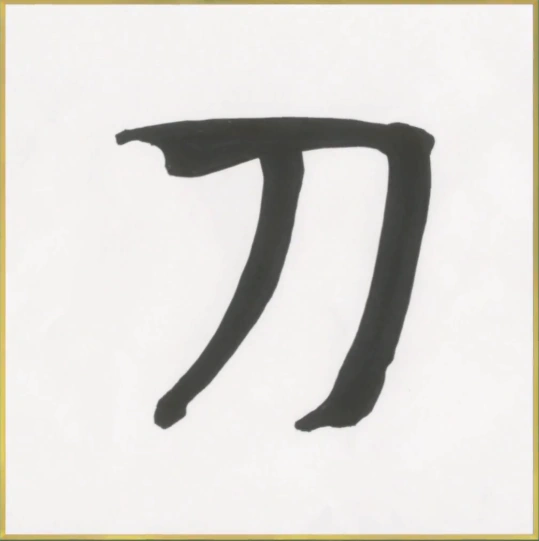
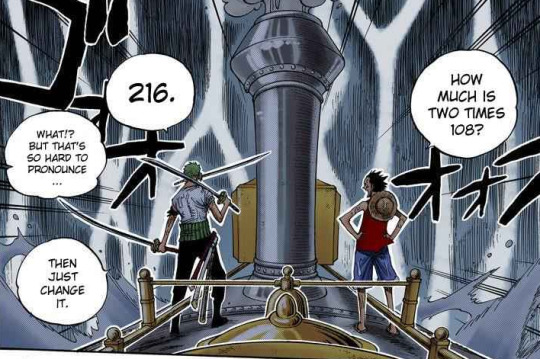
Nami-Stole education books. Not formally educated. Everything was probably taught by Bellemere and the rest was learned on the fly. Probably knows the basics of mainstream world history. Is capable of formulating advanced equations, and has vast sailing, navigation, cartography and weather knowledge. Studied at Weatheria during the timeskip, but it doesn't seem like a formal institution.


Usopp - Orphaned street rat. Unknown who taught him to read, write, and do math. Possibly Banchina before she passed away. Somehow he knows chemistry and engineering? Might have borrowed books from Kaya? Mostly self-taught it seems.
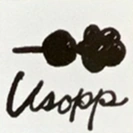
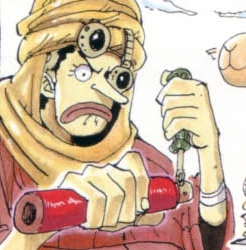
Sanji- Definitely has a formal education, up until he ran away. Noble child who had a variety of tutors. Learned whatever noble children learn plus a variety of fighting techniques and fields of science. Then was taught cooking by Zeff. Boy definitely knows how to do math. Anyone who cooks for a large group of people can at least multiply on the fly, or has a calculator taped to the wall. One Piece appears to use the metric system, so at least he doesn't have to figure out how to quadruple a recipe that originally called for 1 2/3 cups of flour.
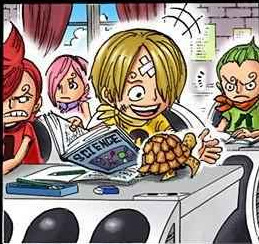

Chopper - Professionally taught by Dr. Kureha (and Dr. Hililuk). They are both referred to as Doctors, but it is unknown what sort of medical knowledge is actually needed for that title, or if there is like a degree or anything. Assumably one of them taught him reading, writing, math, and chemistry in addition to medical stuff. Also read all of the books in the Torino Kingdom during the timeskip. According to the wiki, Kureha established an academy during the timeskip.
After establishing a medical academy, she taught and trained at least eighty students who became skilled enough to join the Isshi-20, expanding their members to a hundred under her leadership.

Robin- Got a degree in archaeology at the age of 8. Has all of the reading, writing, and history skills, including dead languages. While she taught herself how to read the poneglyphs, I think it's safe to say that Professor Clover taught her regular history, math, science, reading, and writing. Robin went to school!
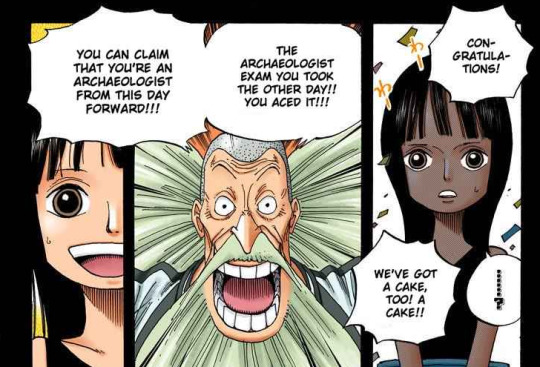
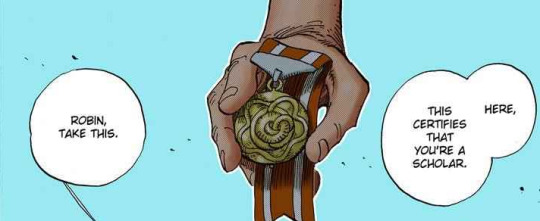
Franky - Apprenticeship under the shipwright Tom. His state of education was unknown before meeting Tom at age 10. Should know all of the basic skills (reading, writing, math) in addition to carpentry, and shipbuilding. Tom's Workers is referred to as a shipbuilding company, so I don't think it counts as a school? Knows at least enough medical knowledge to turn himself into a cyborg with scraps from a ghost ship after being runover by a train. And Survive. Somehow.
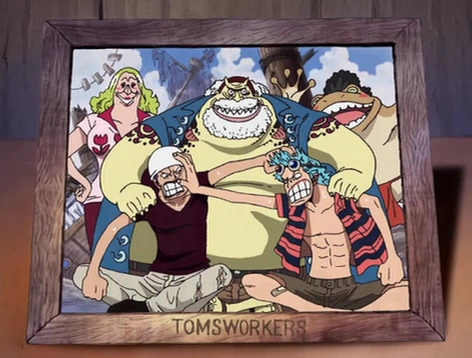
Brook- APPARENTLY??? Stated that school makes him nostalgic, which implies he attended. Also knows a variety of things usually nobility would, namely various musical instruments and fencing. He also knows sailing, and various other things to be a battle convoy leader and pirate captain. I have questions for this man.
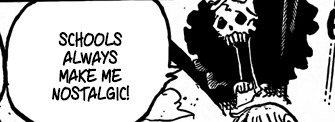
Jinbe - Dojo again, this time the Fish-Man Karate Dojo. Later joined the Neptune Army. So, since a dojo counts as a type of specialized school, he's attended a school as well as had military training! Knows basic historical stuff, especially that pertaining to fishmen and human-fishman relations. Seems to know other basic life skills (reading, writing, math, ect)

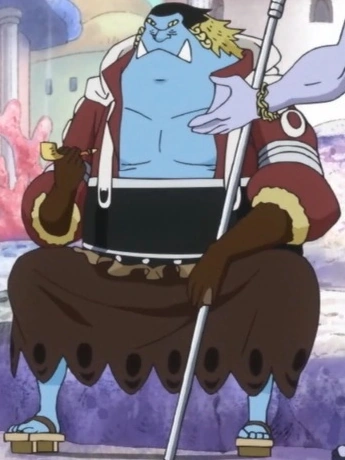
So, in conclusion:
Went to school: Zoro, Robin, Brook, Jinbe
Private Tutors: Sanji
Vocational Training under a Professional: Sanji, Chopper. Franky, Nami,
Self Taught with some instruction by a parent or other adult (non-professional): Luffy, Nami, Usopp
Out of the ten members, 4 of them attended a school of some sort and several others had some sort of professional training or supervision of study.
Feel free to add on if I missed anything!
#most of this was from the wiki and skimming their backstories in the manga#we don't know much about some of the later members actually childhood though#so its hard to say#it amuses me greatly that Zoro is in the school category#one piece#strawhat pirates#one piece chapter 1134#monkey d luffy#roronoa zoro#nami#usopp#sanji#tony tony chopper#nico robin#franky#brook#jinbe#one piece meta#one piece analysis#one piece elbaf arc#elbaf#omg we're in elbaf! its still so cool#my post#this took like an hour help
237 notes
·
View notes
Text
Kicks pebble. The way Darry says “speaking of which, I gotta go pick up my paycheque” right after “you wanna be a fighter? then know just what you’re fighting for” and it’s established (even moreso in the musical) that the only reason Darry’s working so hard is for his brothers and how therefore what he is fighting for his main goal his one driving purpose in life is to keep what’s left of his family together and try and give them as best a life as possible. For a character so bad at expressing his love in ways the ones who need to can understand, he sure has it as his primary motivation
#darry curtis#og#I don’t know if this is articulated well at all but you know how it is#the outsiders#the outsiders musical#analysis#<- we’re getting real blurry with this tag category recently
247 notes
·
View notes
Text
true eldest daughter culture is loving your dad’s favorite movies, but trying to explain to him why those movies are, in fact, gay
#dead poets society#top gun 1986#please contribute more films in this category#eldest daughter#movies#films#subtext#english major#media analysis
61 notes
·
View notes
Text
Solangelo type of dynamic trope
Ok. It's time. Honestly? I've been waiting to post this. I thought I should have read all of ToA before doing so since I could have a better insight of them,but since someone told me that Solangelo is only present in the first and last book,I decided to not wait anymore. Because now I'm pissed about the lack of Will (and Nico) in a serie centred about Apollo and how I never got a bonding moment between them. I'm going to write it on my own,trust me.
Anyway,I saw a couple of people commenting how Solangelo isn't a healthy ship because Will is Nico's doctor and there is a powerplay here. Now,if you are familiar with romance in general,one of the main trope you can find (especially when it cames to fanfictions) is usually the CEO × secretary,where the CEO is in a superior position than the secretary that work for them. They are a figure of authority. There are a lot but this is the most common one and one of the most populars. Solangelo romantic trope technically belong to the same category.
Technically.
Because Will Solace isn't a real doctor.
You heard that right. Will isn't a real doctor,he is an healer,not a doctor. And,other than this difference,is the fact that Will is a teenager that needs to take care of the other campers because he is the only one that can do so. The Apollo Cabin is half dead,there are Kayla,Austin and Will,and Will is the only one right now that can heal someone since his siblings are more in tune with Apollo's other domains.
Will isn't a doctor,he never went to school to get a doctorate in medicine,and he never formally studied to pursue a medical career. Will gets called a doctor because even tho he is an healer,he needs to do everything (cure someone from poison,reattach limbs,give a remedy for fever,extract daggers/arrows/bullets and bandage the wounded,etc...) so calling him just as a healer is too little,since he is one man army when it came to medicine. That's why he is called a doctor. But formally? He isn't.
He is a traumatized teenager with a savior complex,a lot of self-esteem issues,high levels of stress,probably got a caffeine addiction too,with a healing power and acknowledge that keep alive a lot of other traumatized teenagers. Will is a doctor because they only have him,because there aren't real doctors at camp and older demigods are a miracle. Because he is the only one left,after the war against Kronos,that can heal them. Which is depressing by the way-
Where is the powerplay at? Will should be a figure of authority towards Nico right? Should be someone that,if he want,can mess up with his boyfriend health by giving him a bad prescription,right? Here the thing: Will has not that type of authority.
Their romance trope is in that category,but it's completely different. A CEO can fire its secretary (and it's usually happen in romance books/fanfictions) for a mistake. A teacher can give bad grade to their students if they argued. A boss can do what they want with their employees's works if they are in the mood. I can go on and on about this type of dynamic: you name it I got it.
There is also the age difference here. The figure of authority in the relationship is always a couple of years older than the one that stay under them. And that's only for normal romance tropes,if we take in consideration dark romance too....well....then the relationship are a lot mess up,from both ages and dynamics,but we are not cofusing on that.
Solangelo doesn't fall in any of this because Will doesn't have the authority to do anything. He and Nico are both teenagers that are trying to live without dying (or almost). Will himself is a person that would never use his "leverage" to hurt Nico or damage him or someone else. And Nico isn't stupid,he know that if something goes south he can protect himself. But it won't happen. Because they do not fall in that stereotype of powerplay dynamic.
Also,Nico literally used Will position as a doctor to have more leverage,and be more with him. The "mood disorder" is just a cover so he can spend more time with Will,eat with him (he also probably didn't want to eat alone because of the tables rule) and doing activities with him. He used the "doctor note" excuse to make his way into Apollo's plan because he didn't want to let Will alone because he was worried. If you need to worry about someone in this dynamic it's Nico di Angelo,not Will Solace.
If you need to pick a bone with this ship you can do better and try to make them look unhealthy because of their trope dynamic. They aren't that. And there are probably more other things you can talk about to disagree with their ship,but hating on Doctor × patient type of ship,when there are a lot of those everywhere,is stupid.
#percy jackon and the olympians#heroes of olympus#percy jackson and the heroes of olympus#trials of apollo#nico di angelo#will solace#solangelo#apollo cabin#writing analysis#stereotypes#ship dynamics#will might be nico's doctor but he doesn't abuse of it#people that try to use this as a way to make their relationship bad are dumb#they are in that category but are a totally different shade of it#they are healthy#and happy with each other#will is only called a doctor because he does too much for being only an healer since he is the only one that can keep everyone alive#nico know how to take care of himself and know that will is perfect for him#he take advantage of that in ToA to stay with him#where is the powerplay/authority differences at???
27 notes
·
View notes
Text
I don’t talk about Kanji much but I do really love him and his social link. I’m not going to focus on the whole arc of it (which is how opening up and being honest about yourself is honestly much better for you than letting people’s preconceived notions influence you), but I am going to focus on a piece of it—namely his dynamic with the “doll boy.” To be honest, I think he and that boy needed each other’s reassurance in a sense. Both he and the boy were mistreated by other kids their age for “not being masculine enough.”
During Kanji’s fourth Social Link rank, the little boy has his friend’s stuffed rabbit thrown into a river by a bully because the rabbit is seen as “girly.”

Kanji looks for the stuffed rabbit but can’t find it, and then immediately decides he can make a new one and asks the boy what the plushie was like, and makes the doll boy’s friend Sana a new plushie. He especially feels compelled since he can relate to the boy’s struggle.

But after making the plushie, thanks to the mistreatment Kanji himself has faced from his peers for being able to sew, he’s actually embarrassed to admit that he made the plushie, to the point he’s reluctant to—the protagonist can tell the child, or Kanji can hesitantly tell him.

(Ehhh, don’t think I did a good job on this edit…)
But the kid praises him, much to his shock, and asks for more handmade plushies from him. He actually asks Kanji to teach him how to sew, which startles Kanji… who obliges and uses the Dojima house to teach him and some other kids how to make puppets out of oven mitts.
This kid, this boy, mind you, broke Kanji’s fears and allowed him to have the confidence to make plushies all he likes—he’s making money for his mom and pursuing his passion for sewing that he used to get judged for. By admitting a piece of himself he kept locked up to a kid so similar to him, he actually got an open outlet for his love of sewing. And again, he’s supporting the family business. There are ZERO downsides to this for Kanji! The kid actually helps him later with the police, who don’t believe it initially when Yu and the kid explain what happened to them, which helps tie into the message of Kanji’s social link.
And for the boy, he actually got a doll he loved for both himself and his dear friend Sana, and became allowed to pursue a newfound passion of his without judgement or fear of being seen as “not enough of a man—” an older man (…relatively speaking… Kanji’s a 15-year-old boy…) is literally teaching him. And Kanji is one hell of a guy!
It’s a really sweet story and proof how a positive influence, whether older or younger than you, can change your life for the better and help you be comfortable in your own skin. People want to be accepted by those around them, but due to people’s prejudices and biases—and oftentimes these biases are so sweeping as to be baked into a society—people are often contorted into boxes they can’t fit into, and when they don’t fit, they’re mistreated. Like Kanji, who ended up putting up walls due to belief he’d never be accepted by others as a proper man, and the boy, who only began to become more outgoing and able to pursue his interests (like plushies and sewing) when he had another guy in his life who proved that what it meant to be a man wasn’t nearly as restrictive as he’d been taught to believe by the toxic masculinity perpetuated by his peers, small children around him (who had been likely taught this toxic rhetoric by their parents). They were a mutually positive influence on each other. And I think that’s beautiful, even if the context behind their appearances in each other’s lives are so important is actually rather sorrowful.
Kanji’s easily my favorite Emperor Arcanum. I love him a ton.
#persona 4#persona 4 golden#Kanji Tatsumi#I love this not-so-little catfish#<- joke on his Persona being associated with a catfish that causes earthquakes#yes that’s actually the myth#this is a bit shorter than usual but that’s probably because I wasn’t looking at the full arc of his#I have a longer post about one character coming and a HUGE post about another character#maybe I should do a long analysis about his entire social link.#dunno if I will#maybe once I have another Category 5 Catfish Event#analyzing the fog
32 notes
·
View notes
Note
Is there an archive for all of your analysis? I want to read them in order 🙇♀️
I was gonna say yes and link you to the in-built tumblr blog archive with my tag ‘analysis’ but then I remembered I tag inconsistently. Oops! So here is a huh, attempt. Chronological order is less important imo than topic but for what it’s worth these go from oldest on the left to newest on the right. This got too much for Tumblr to handle so unfortunately I have to split between reblogs.
This is all for Dunmeshi because I haven’t done nearly as many analyses for anything else. My older ones tend to be less polished, I’ll put my most important or favorite ones in bold. Many of this contain spoilers so for that be careful and refer to individual posts’ tags.
Masterposts: laimar crumbs (discontinued) - marchil crumbs - Chilchuck’s family - beastkin tattoos - Nakamoto household
Compilations: Marcille’s smile to Laios - Izu dad Chilchuck - Laios bragging faces - Teasing Marcille gone wrong - Chilchuck drunk/drinking - Chilchuck being crass - Chilchuck hugs (incomplete) - Kaka - Hien & Benichidori - Marcille & Chilchuck worsties (incomplete) - Chilchuck old man posture (incomplete) - Chilchuck's type 🤨 (incomplete) - Chilchuck wristwatch - Helki - Marcille and Chilchuck parenting Izutsumi - Marcille in elven dresses
LAIOS: Succubus scene analysis - Laios-Shuro fight analysis - Izu-Laios relationship analysis - autism & the nonhuman - Laios' nightmare aka autistic existential horror - Laios and chimeras
MARCILLE: Mothers & mom friend Marcille - Chil & Marcille contrasts & parallels - love languages - Marcille and separation - Marcille's view of Chilchuck - Marcille and romance - Marcille and being a burden - Marcille and insecurity - Marcille's dunlord dress / tldr - Dark elves - The fantasy of prince charming and idealization vs pessimism
CHILCHUCK: Chil’s sense of humor - Chil & Marcille contrasts & parallels - love languages - Chilchuck is underweight - Chilchuck’s family masterpost - Chil’s wife’s appearance - Chilchuck character analysis speedrun - Ask: Chil & wife and change - Ask: Chilchuck, good husband? - Chilchuck’s succubus - the importance of law - getting hired & job description - Chil's buckle shirt & wardrobe - Chilchuck, family & alcoholism - Chilchuck & guilt - Chilchuck and drinking: when and how - Korean QnA observations & wedding question - Is Chilchuck misogynistic? - Chilchuck’s nightmare - his wife as his succubus? - Dungeon lord Chilchuck - Chilchuck's arc and closure
FALIN: fairy’s child parallels - short Falin analysis - Falin who cares too much and too little - Thistle & Falin - Trans Falin - more & shorter Thistle & Falin
THISTLE: clown costume & belonging (+ read tags) - Homegrown (web weaving) - Thistle & Delgal and death - Yaad & Thistle - Thistle & Falin - more & shorter Thistle & Falin
TOSHIRO: Nakamoto household masterpost - Toshiro likes bugs + Falin relevance - Toshiro’s succubus - Trans Toshiro (and Falin) - parallels to Kuro and Forva - Toshiro's nightmare
(other characters in reblog)
Marcille & Chilchuck: marchil crumbs - contrasts & parallels (not ship) - Taking care of each other sick - Marcille & Chil’s daughters - their love languages (ship but analytical focus) - pre-canon dynamic (not ship) - astrology (ship & short) - Chilchuck's type 🤨 - waxing poetic (good summary) - marchil from Marcille's end - Marcille and romance - marchil & stability - Marchil braids - Red dress crumb evaluation - even if he loved me he would never say it - Marcille and Chilchuck balancing each other - the immortal x mortal dynamic - Arc analysis - The fantasy of prince charming and idealization vs pessimism + drowning excerpt
#fumi updates#i might eventually make Daltian clan its own category#oooh when my Marcille & chil arc analysis drops!! when it drops!!!!! When it'll drop everything will change!!!!!#rn ik I've been wanting to add points to the marchil love language post + the half-foot marriages post + pre-canon marchil post#these aren't all the dunmeshi posts I've done but the ones not listed here are just screenshot compilations and “hey look guys!!”#ask
122 notes
·
View notes
Text

hi. i made a chart
#trying very desperately to change the category names in such a way that these three main groups would remain grouped together#but i would be able to also group saejima lee and kiryu together#open to suggestions#yapping#majeem#my analysis#?
30 notes
·
View notes
Text
I'm gonna write my guesses on the possible IDs we'll get during the next Limbus season. Specifically the Canto story IDs.
I'm gonna drop this funny lil chart I made and I'll come back later to write out my assumptions. Feel free to reblog with your own guesses or comments!
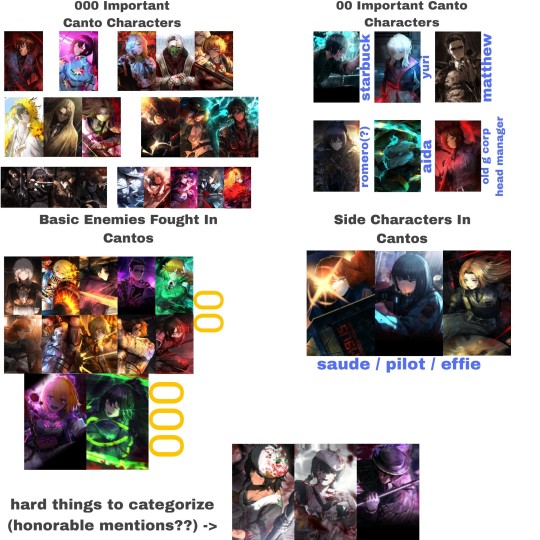
(I went off the wikis when it came to sinners being based off of characters, but feel free to leave a comment if you have opinions on formatting or think I should've added something)
#limbus company#staring at gregor and heathcliff snd wondering why they have so many 000 when it comes to story-driven IDs#this started with me just wanting to make an estimate that sinclair would get a 000 along Hong Lu next season and then...#....evolved into whatever an attempt of an analysis this is#my bets are towards sinclair and faust ids along hong lu.#maybe an ishmael 00? i could possibly see an ishmael jia xichun id but thats a stretch#my next goal is to make a list to see how many times characters show up in different categories(staring at gregor) and make a better guess#i downloaded so many photos onto my phone for this and my app to make this only lets me add 10 photos at a time. it was. interesting.#limbus
22 notes
·
View notes
Text
Tell me: Is He Gay or In a Sherwani?
Imposition of western norms in fandom analysis of Asian characters
With the rising popularity of Indian cinema sparked by the recent success of RRR on international platforms as well as the easy availability of multiple streaming services, in addition to the appearance of South Asian characters in prominent roles in western, particularly US media, I've begun to see some concerning 'analysis' posts online. So I thought I'd address something I found common in most of these takes.


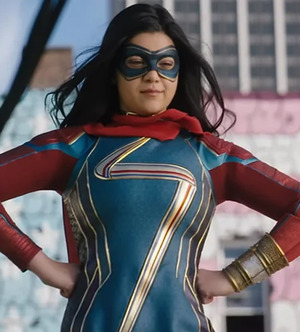
Guys, characterizing your blorbos as queer is great and all, love it, but you're making a fundamental mistake by making their clothing choices the foundation for your queer headcanons, especially when it comes to male characters. Do not apply existing western cultural ideas regarding male clothing onto South Asian characters and their dressing please.
The vast majority of the clothes being used by people in various online spaces as 'evidence' of a character being queer(gay or bi mostly) are just normal Indian clothing for men, like daily wear. A top being pink or a character's wardrobe being mostly pastel means absolutely nothing...cos Indian clothing tends to be colourful in general and the tendency to ascribe colours masculine and feminine qualities is considerably less in the subcontinent. I'm not saying it doesn't exist, but generally not a concern.
There's also this pervasive idea that colourful clothing = flamboyance = queer and that itself is something many people have already pointed as a deeply flawed way of thinking and a stereotype. Furthermore, even if you do lean into the archetype of queer men being flamboyant, subscribing to the 'stereotypes exist for a reason don't they?' school of thought perhaps, there's also the fact that ideas of what is considered flamboyant change dramatically across different cultures. What is 'flamboyant' for someone might just be normal for others. Like maybe pink or purple or yellow might be considered too much, unmanly, emasculating etc in the US or something but they're just perfectly normal colours for men to wear in many, many cultures.
It's the 'Is he Gay or European?' principle. Did you characterize this Indian character (or any South Asian character really) as queer because of their canonical behaviour and portrayal, or did you just see their clothing and decide they're queer because being well groomed and having a colourful wardrobe is a character trait you exclusively ascribe to being queer?
Like guys, I like Chaipunk like the rest of you, but if you consider Pavitr queer just because his costume is a lot fancier than the others' (An actual take I've seen multiple times) without taking into account his cultural background....¯\_(ツ)_/¯
Let me make this clear, I don't think people need a ten page analysis to imagine their fave as queer. Headcanoning a character as queer can have any reason ranging from 'I said so and so it is' to 'this is my light character analysis that makes a masters thesis look shabby' and they're all valid and an integral part of the fandom experience. What I am annoyed at are these so-called 'well-researched' theories that did not make the slightest effort to look into South Asian culture and simply transposed their western bias onto Indian media and confidently make flat out wrong judgements and mislead other people. Clothing based sexual identity determinism is the least of it. That I can at least understand through the lens of a habitual process built through years of analyzing crumbs of queer representation available only through queer coded characters and symbolism such as clothing choices being the only way to see an aspect of yourself portrayed in an aggressively heteronormative media ecosystem. I do that too, because media is tragically heteronormative everywhere. But the rest? Its just straight up misinformation and misrepresentation touted as truth.
Its the same with relationships between men. There are plenty of cultures where skinship between men is not unusual and dynamics and nuances tend to be vastly different from western representations of male friendships. In xianxia and wuxia fandoms you can see this same problem in a different font when outsiders, most often the western side of the fandom, try to apply their own standards and morals onto the original work and try to interpret it through a lens it was never supposed to be interpreted through in the first place, except maybe for comparative analysis. This practice itself isn't a major problem, its natural for people to apply what is familiar to them to try and understand something new. But when this is also accompanied by them foisting their personal interpretation and analysis as the 'correct' one and trying to impose it on the fandom as a whole, it escalates into a powder keg situation as you can imagine.
Again, not saying that western parts of fandoms are the root of all evil or anything like that, gods know how toxic netizens can be. But in this specific situation, where people try to impose western ideals on to non-western content and assumes the universalism of their own principles and value systems? Indeed an issue to be addressed.
#ATSV#South Asian Characters#Desi characters#South Asian culture#Desi Culture#Fandom analysis#LGBTQ+#Brown culture#Spiderman: Across the Spiderverse#Pavitr Prabhakhar#Hobie Brown#Chaipunk#RRR#Miss Marvel#Tagging Miss Marvel and RRR only because they're in the intro-two pieces of media that are good examples of the increased attention-#on South Asian characters and Indian cinema#Not included in the body of the post except under umbrella terms like South Asian character/South Asian media & other such categories
248 notes
·
View notes
Text
Finally decided to write up a proper post on Bad winning the island popular vote, because it really is such an impressive feat by him. And, obligatory disclaimer, this isn’t to discredit Forever or Etoiles at all, my blog is just here to hype up my streamer.
Q!Bad started on this island without a family. He’s a single dad, he didn’t receive any connections to other people, and there was barely any unity between English speakers. The trust he built up between him and the islanders is wholly through his own efforts. While a big reason he lost the community vote was because his community is smaller, another was that he had difficulty communicating what exactly his platform was to a wider audience. And that’s what makes his creator vote win even more impressive: the islanders voted him despite a good chunk either disagreeing with his platform or not knowing exactly what it was.
Bad won that vote through his merit. Yes, a lot of people enjoyed his ideas of anarchy, especially after Gegg and Baghera were eliminated, but I don’t think Bad ever needed a good platform to garner votes. Spawn was completely redone into a warp system by him. He’s the first to babysit an egg, the first to gift totems, armor, or anything else a person asks for. He’s always talking to everyone, hell, everyone wants to talk to him. If the election had been solely based around who the islanders wanted as president, Bad would’ve won. And he would’ve won while still throwing his own two votes towards his biggest competitors.
I know cc!Bad was disappointed with how close he got, and I hope he knows how impressive it is that he won in two out of the three categories. Now, maybe he can demonstrate why the islanders maybe shouldn’t have voted for him, and unleash the bloodthirst inside him lmaoo.
#qsmp#badboyhalo#just. MY STREAMER!!#and i saw that chat go into damn emote mode every time he led in a category#and those crying emotes#and i just want to say to those miserable chatters: BADBOYHALO 🔛🔝!! LOSERS!#analysis
216 notes
·
View notes
Text
An analysis of WKTD and HWBM in relation to psychology, Christianity, and oppression.
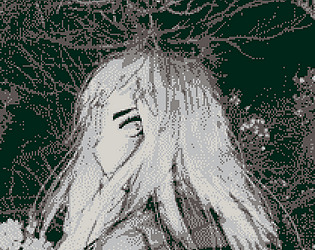

Spoilers for almost all of We Know The Devil and parts of Heaven Will Be Mine (only stuff from when you play as Saturn tho that’s the only character I’ve played as so far)
This post is very much off the cuff so it is quite messy but I really needed to put my thoughts into words, I guess. Hopefully it makes sense, and sorry if there’s any errors!
vvv Analysis under the cut because this post is LONG vvv
Okay because when WKTD said “the devil is the shadow of man cast from the light of god” and when HWBM said that the Existential Threat was just a byproduct of the shadow of humanity cast from gravity (via humanity’s Culture) its like the enemy that humans want to fight is just themselves. The concept of the “shadow self” (also called the id, but I’ll be using shadow instead) in psychology refers to the parts of oneself that does not fully fit in with what society expects of them (Super-ego) and sometimes separately from the true self (Ego), typically leading to rejection of those aspects and self-conflict.
Now, please note that I haven’t 100%’d HWBM but I have 100%’d WKTD, and in that game the true ending results in the main trio all becoming devils and embracing those sides of themselves they’ve been running from for the entire game. The thing I quoted earlier is an actual line from the game said by god, the line following it being “the meaning of this phrase is that there is no devil.” Only through self-acceptance and helping each other alongside ourselves do we really reach the true ending to these stores.
While WKTD leans more towards individuals, HWBM puts more emphasis on the idea of the collective shadow; the story still focuses on individuals, yes, but is very much about the conflict between a humanity that is tearing itself apart over the things that don’t fit the collective image. The main conflicts of the story focuses a lot on that general unrest, and was initially the Existential Threat, but after that dissipated humanity still saw its own shadow, this time in itself. An email you can find in the game even says that “In abandoning Existential Threats to address the threats of our home, it will inevitably result in us turning to conflict between humans one more. And in turn, the Existential Threat will thrive.” The Existential Threat literally feeds on unrest and trauma, manifesting as paranoia and leading humanity to fight it, only for them to find that they were just fighting their own literal shadow.
It’s also important to note that HWBM briefly mentions that the Existential Threat is tangentially related to “their cousins on Earth, and even those are so weak kids with radios can take them out”. This, while it can easily be seen as a nod to WKTD for those who played it, the fact that the reference is super blatant (along with the mention of the Scout programs, likely referring to groups like the Summer Scouts from WKTD) leads me to believe that these two stories exist in roughly the same universe (or at least their worlds do, maybe not the characters present in the stories themselves existing at the same time*). This is for a very specific reason, and it has to do with the themes both of these games are tackling, regarding acceptance of the self, both on an individual and societal level, symbolized by the apple.
Both games reference the apple when talking about the idea of becoming something new, sometimes even beyond humanity. It’s about the embracing of the shadow and all the parts of yourself, seeing yourself as a whole being and accepting all of it. The joy and contentment brought upon yourself by finally letting go of all that repression and division, even if the world around you is going to perceive those parts as scary or ugly. Bad endings in these games are brought about by rejection of the self, which makes sense considering all the themes around queerness and transcending one’s humanity, so obviously and fittingly the true endings focus on healing oneself by accepting all of their aspects as part of the greater whole.
The apple in these stories, especially noticeable in its original thematic incarnation in WKTD, is in reference to the fruit from the Tree of the Knowledge of Good and Evil in the Garden of Eden from the Bible. Man was forbidden from eating the fruit, but Eve (VERY important to note that the dev studio is named Worst Girls Games btw) is tempted by the serpent (was not originally the devil, but came to be in the New Testament) to eat the fruit, which they do and become aware of themselves. God banishes them from the garden for breaking this rule he set out for them, also punishing the snake in the process due to how it tempted Adam and Eve. This incident is referred to as the “original sin.”
What is interesting about this part of the Bible though is what God says at the end of Genesis 3, right before the banishment actually occurs: “And the Lord God said, ‘The man has now become like one of us, knowing good and evil. He must not be allowed to reach out his hand and take also from the tree of life and eat, and live forever.’” The specific wording of “become like one of us” in the context of the apple metaphors from the games from Worst Girls Games is super intriguing to me, mostly due to how the idea of becoming something new is super common throughout these stories—becoming the devil in WKTD, and becoming one’s Ship-Self in HWBM.
There’s also the framing of the serpent in these stories, as well. The serpent in modern Christianity is almost always depicted as the devil, tempting humanity away from God throughout almost the entire scripture. In the book of Revelation, the devil is said to have gone to direct war against God and fighting against his angels; “Then war broke out in heaven. Michael and his angels fought against the dragon, and the dragon and his angels fight back. But he was not strong enough, and they lost their place in heaven. The great dragon was hurled down—that ancient serpent called the devil, or Satan, who leads the whole world astray. He was hurled to the earth, and his angels with him.” These verses can easily be seen in parallel to WKTD, with how the devil forms are said to be unstable and her world more fickle than god’s, and how in HWBM the Ship-Selves are delicately maintained by the Lunar Gravity Well.
But here’s the thing: the framing of the devil in these stories puts it in the position of being correct, with humanity making the right choice to follow it. This may sound strange, almost like villain behavior, until you remember these games deal with themes regarding repression of the self under an oppressive society, which is why these societies tend to be characterized by Evangelical conservative Christianity. Under this lens, alongside the themes of queerness and transcending humanity (rising to the throne of god, in a way), everything begins to click into place. The idea of being forced to live a certain way by a society that hates parts of your very being is killing our main characters, and they want a way out. The personification of the Collective Unconscious (ex: the devil) gives them this out—even if it’s less concrete and stable than the known world (the light), the unknown world (the darkness) is what truly gives our characters the freedom they desire.
They cannot do this alone, however, as we see in the Bible further into the book of Revelation, when the devil is aided by a beast from the sea and a beast from the earth, all three of them holding one another up and emphasizing one another’s’ powers and authorities. This, of course, most likely is reflected in the games in the main trios we play as. While I am still unsure about specifics, I trust you guys enough to understand what I’m getting at here, even if my speculations are likely flimsy at best. Either way, the idea gets across—the true endings for the games can only be obtained if everyone supports one another properly.
The scripture states that the devil does not have long on earth to do what he wishes (“… [The devil] is filled with fury, because he knows that his time is short.”), but that doesn’t stop him from trying at all. When it comes to the games, in WKTD the main trio stay in the cabin only for the night (player choices start at 7pm and the final one is at 1am, 2am onward being the ending you got, so choices go on for 6-7 in-universe hours), and in HWBM they have eight days to get back to earth before humanity declares them to be a threat. In both stories, our protagonists are all under strict time limits to do what they can in order to get the outcome they desire. As it’s said in WKTD, “the devil only ever gets one chance.”
Even though in the Bible the devil is ultimately defeated, in these games it’s the opposite. This is less about the theology they draw from and more having to do with undoing oppressive power structures through solidarity and community support while doing what you can to avoid infighting. Systems of hate and oppression are easily undone, which is why they put in so much work to scare you away from even trying to undo it and make you fall in line; resistance scares oppressors. Of course, resisting is not an easy task, but that’s just part of the work—they don’t call it a fight for no reason, after all.
Accepting all aspects of yourself and embracing that is the first small, yet very important step, to rejecting oppressive systems as a whole, and when society as a whole accepts what the system rejects, that system will inevitably fall, freeing those who are under it. Even though the world that comes after may be more uncertain and unstable that the last one, we still have each other to rely on and a foundation to build something greater and healthier than before.
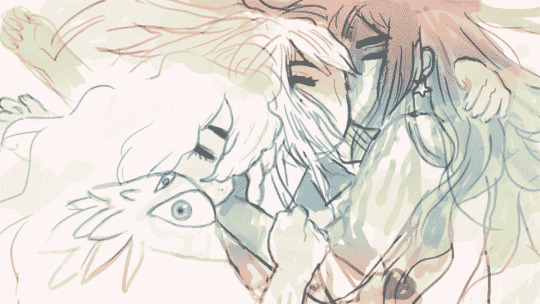
So, roughly and basically…
Super-ego = God = Culture
Ego = Humanity (consistent throughout both games)
Projection = Light = Gravity
Resistance = Radio = Ship-Self
Shadow (personified by Collective Unconscious) = The Devil = Existential Threat
Acceptance (of the Shadow) = Apple (consistent throughout both games), characterized by devil possession forms and Ship-Selves (Ship-Selves are dual natured like that, I think)
… Or something like that. I dunno, I’m not a psychologist.
Once again, I have seen all of WKTD, so I can say these things concretely about that story. However, I have not seen all of HWBM, so it more so feels like I’m making guesses as to what happens in that one, so just bear with me. I’ll be super hype if I’m correct in my theory/analysis.
*On this note, it is very amusing to me to imagine the WKTD trio as space mech pilots. The idea of the main cast of HWBM having to deal with devil possessions is also very fun :3
Sources for information + screenshots I’m referencing
Wikipedia: Shadow (psychology) (links throughout the article lead to other things I’ve mentioned like the Collective Unconscious)
Bible Gateway: Genesis 3, Revelation 12, Revelation 13 (New International Version)
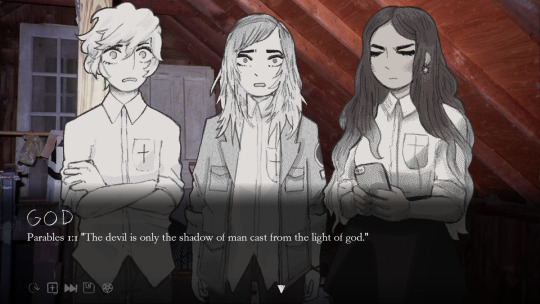
(from WKTD) (not my screenshot, stole this from my friend) (hi Ash <3) (platonic)
(I don’t have a screenshot of the line that comes afterwards or the line talking about the metaphorical apple in the epilogue of the true ending but I know they’re there. I have it in my brain. I’m too lazy to get a picture of it just trust me I know what I’m talking about trust)
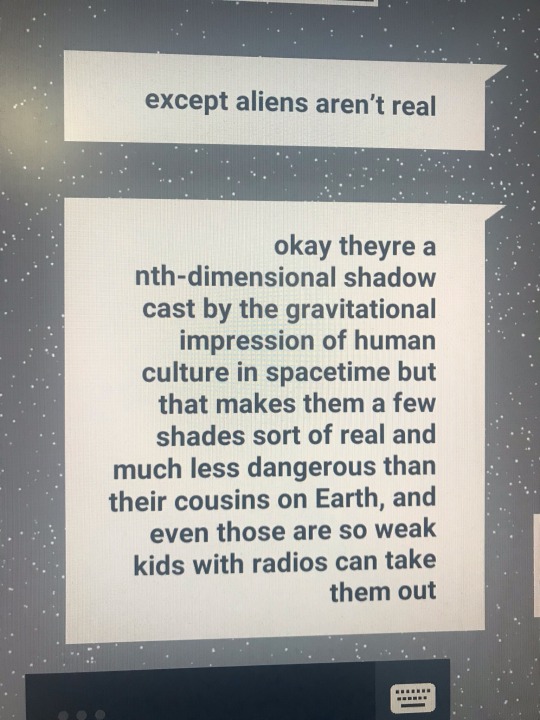

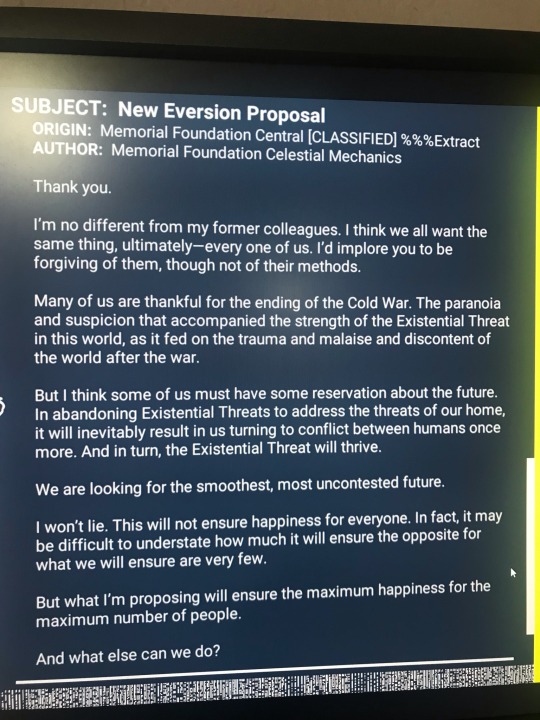
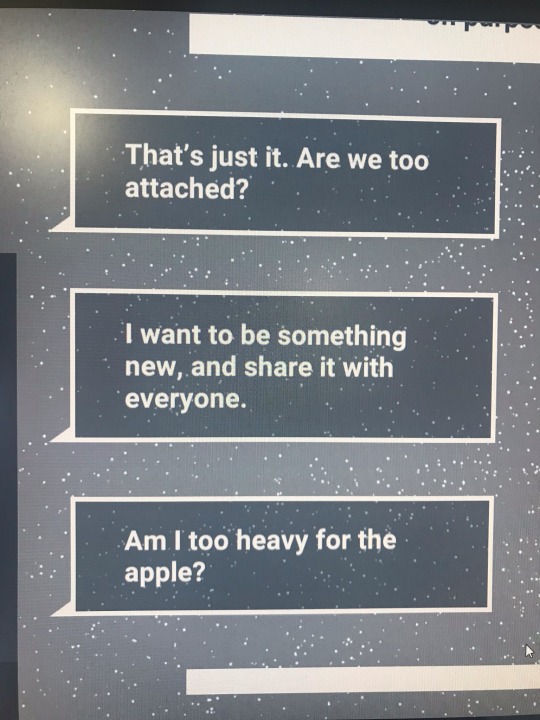
(from HWBM) (screenshots taken by me)
(I don’t have absolutely everything either just work with me here sorry)
#rambles#hwbm#wktd#analysis#sorry guys I had a category 10 autism event and needed to get this out of my system#we know the devil#heaven will be mine
132 notes
·
View notes
Text
Kanade is selflessness born of selfishness (because she wants to atone for what she's done by saving other people, she works herself to the bone and doesn't care about her own well-being - but that desire to save others is ultimately something that she believes will be her redemption, without a care of why or who she wants to save. Mafuyu notices that, and a large part of Kanade's story revolves about her learning to want to compose and save out of earnest desire to help rather than the idea of making up for a crime that only she herself thinks she's guilty of)
An is selfishness born out of selflessness (she wants to go to the height her father and Nagi were, and beyond that - surpassing Rad Weekend, an event many people consider a monument rather than a goal point to be passed - something that appears to be so incredibly selfish, but she does that because they wanted her to. She's taken on the burden of her family's crushing legacy because they placed their hopes and trust in her and An is so utterly selfless she could never say "no", no matter how hard it would be, how much it hurts. An is a bearer of a dream so inherently selfish but one that is passed upon her regardless of her will, and she is so utterly selfless that betraying those hopes was never an option)
Oh to be narrative foils with someone in proseka universe.
#jay rambles.txt#project sekai#an shiraishi#kanade yoisaki#jay's character analysis#you can also add other characters into both categories. btw#touya for the first one. tsukasa and minori for the second one. smth smth#probably more
68 notes
·
View notes
Text
Ben the Magnificent, by the numbers
(This is really just me making a handy rewatch guide) 1x04 4 (Ben, Lila, Kristen, Kristen) 1x08 1 (Lila) 1x09 1 (Andy) 1x12 1 (Lila, Lila is the one who hugs him and drags him over by the hand) 1x13 1 (Laura) 2x04 1 (Laura) 3x03 2 (Lila, twice) (Laura is the one who talks to Ben in 3x10) 4x02 1 (Laura) 4x11 2 (Lila, Ellie pretending to be Laura) 4x14 1 (All four Ls) 14 total utterances of "Ben the Magnificent", plus Lila's "you're not very magnificent lately" makes 15. 8 of them (over half) are from season 1. Lila racks up 6 of them (a little less than half), and Laura 3 (around 20%). So, it turns out that Ben's relationship with the girls isn't fully equal. Lila and Laura have a particular affinity for him. I wonder if there's a connection to my impression that Lila and Laura are the ones who tend to drive the nonstop chatter during the overlapping talking moments, whereas Lynn and Lexis tend to have more beats and non-spoken reactions (i.e. facial expressions) in their contributions to the flow. Of course, there's an element of actor improv tendency to those cases. But, it does bear out in the scripted lines that Laura is always pretty mouthy and forward with her opinions while Lila is the smooth talking liar. They are the two who coordinate on the "we put a kid from school in the toilet" joke in 3x03. Lexis and Lynn are more measured in what they say, more often asking questions or making observations than stating opinions. Interesting that it is then Lexis and Lynn who have the more spiritually-related arcs in the show. This split is then reinforced by the plausibility of Ellie-pretending-to-be-Laura spinning the future of Ben having encouraged Laura to go into cosmology.
#evil cbs#lila bouchard#laura bouchard#lexis bouchard#lynn bouchard#the ls#category: tv#ben shakir#mfs fans fear not this is not true brainrot; it's like ls dynamic analysis brainrot at most#and this post covers most of it#the other main curiosity is formation/cuddle pair trends and that would be waaay too much work
20 notes
·
View notes
Text
kinda wild that the original star wars trilogy is just about not being a hater. you can tell this from the way obi-wan says “don’t be a #hater luke”
#analysis I have been pondering for a while#that’s my final review#oh shit I need to update my media spreadsheet#should I add a category for discrimination against haters
9 notes
·
View notes
Text
The Triaxial Theory of Horror
I have a theory that most horror fits into a volume of conceptual space described by 3 axes, which are:
Discrete--Diffuse
Mobile--Sessile
Wet--Dry
The Discrete--Diffuse axis describes the source of the horror. A Discrete horror has a physical, usually tangible form; is recognizable as the source of the horror; and takes actions which make it horrifying. On the opposite end of the scale, a Diffuse horror is one with no obvious source, center, or primary actor. Most of Steven King's work falls on the Discrete end of this scale; Silent Hill falls close to the middle; and The Others lands on the Diffuse end.
(As a note, any point on this axis can be done badly; hamfisted Discrete horror rapidly enters a space I call "Ooga-Booga Horror," where the object/entity/what-have-you is so cartoonishly scary as to wrap back around to being silly. Likewise, poorly handled Diffuse horror becomes "Vapor Horror," which is so completely sourceless as to be nonsensical.)
The Mobile--Sessile axis, meanwhile, describes the behavior of the horror. A Mobile horror is one that hunts, pursues, clings, reappears, or otherwise moves around; 80's slasher flicks being a prime example. Sessile horror, in contrast, stays put, and the horror derives either from the inability to escape its radius of influence or the inability to stay away; The Haunting of Hill House nearly exemplifies the far end of the axis.
(Here, too, poor handling can lead to the inversion of horror into comedy, on a scale from "Imma Gonna Getcha" to "Just Leave, Bro.")
Finally, the Wet--Dry axis deals with the effects of the horror, and is essentially equivalent to the gross-out factor. Typically, Wet horror is rich in blood, brains, and body parts, while Dry horror keeps its victims physically intact; however, this scale is not necessarily coupled to the presence or absence of viscera. For example, The Color Out of Space involves significant bodily disturbance, yet remains relatively Dry due to the elision of details. In the same vein (but in the opposite direction), Crimson Peak is an exceedingly Wet horror film, yet utilizes actual gore quite sparingly, preferring to shift the language of decomposition onto the inanimate house; yet its substitution of red clay for blood in no way lessens the Wetness of the horror.
(And as expected, this axis has its own hilarious pitfalls; over-the-top gore rapidly enters "Blood Fondue" territory, while excessively dry horror risks becoming "Totally Scary, Trust Me." Some would argue that The Color Out of Space indeed represents a plunge into the latter category.)
Some examples, then, of the triaxial scale in action:
NBC's Hannibal is Discrete/Mobile/Wet. Hannibal is the primary source of the horrifying events, he can and will chase you down, and when he does, it's going to get messy.
Saw is Discrete/Sessile/Wet. While the threat of bodily harm is similar, and its source similarly known, as in Hannibal, the texture of the horror is significantly altered by the confined setting.
House of Leaves is two horrors stacked up in a trench coat: the parts dealing with The Navidson Record are Discrete/Sessile/Dry, while Johnny Truant's narrative is Diffuse/Mobile/Wet.
Likewise, The Shining nests Discrete/Mobile/Dry horror (Jack chasing Wendy around with an axe) inside Diffuse/Sessile/Wet horror (the Overlook Hotel itself).
Silent Hill, as mentioned, is close to centered on the Discrete-Diffuse axis, and is also nearly centered on the Mobile-Sessile axis, although it is consistently Wet.
The Magnus Archives utilizes all three axes nearly to their fullest extents, but tends to cluster in the Discrete/Mobile/Wet octant.
To be sure, there are elements of horror not described by these axes--internal vs. external, active vs. passive, certain vs. uncertain doom--but as a system for interpreting and categorizing the main structural elements of horror, and particularly for describing one's preferences in horror, the triaxial scale functions well.
117 notes
·
View notes
Text


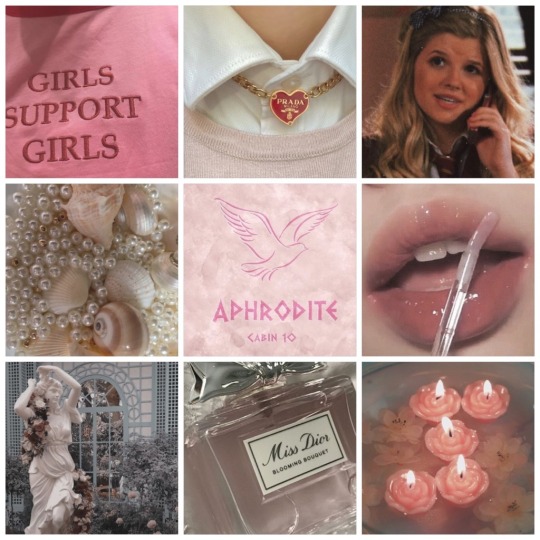
Nina Martin, daughter of Hades, god of the dead, and ruler of the underworld.
Fabian Rutter, son of Athena, goddess of wisdom, warfare, and battle strategy.
Amber Millington, daughter of Aphrodite, goddess of love, beauty, sexuality, and passion.
#ok so look nina took me FOREVER#she was almost a child of apollo too#she was also almost an athena child but that’d make fabina… yknow lets not go down that road#but listen it makes sense Hades is her godly parent; death has surrounded Nina her whole life and her chosen one powers are similar#her parents died when she was a kid; she sees ghosts (sarah; the frobisher-smythes; senkhara; victor sr.)#she has a fear of skulls (and thus death if you wanna think harder on it) i also read an analysis by someone here ab that fear#i like to imagine that while she is a child of hades she is absolutely TERRIFIED of what that entails#she’s afraid of what kind of power lingers inside her because she already doesnt like it; she does NOT want to embrace it#anyway that’s another story; all about personal growth and development#fabian is a child of athena#he’s the brains of group (so is nina but you get it) and in s3 he is left in the brains of the group category solo#amber’s is perfect are you kidding she’s the first one i made#house of anubis#nina martin#fabian rutter#amber millington#hoa
97 notes
·
View notes